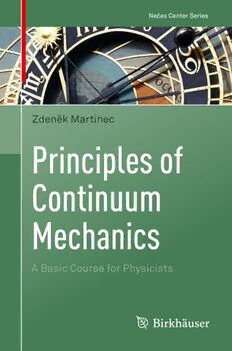Table Of ContentZdenek Martinec
ˇ
Principles of
Continuum
Mechanics
A Basic Course for Physicists
Necˇas Center Series
Editor-in-Chief:
JosefMálek,CharlesUniversity,Prague,CzechRepublic
ManagingEditor:
BeataKubis,CzechAcademyofSciences,Prague,CzechRepublic
EditorialBoard:
PeterBastian,UniversityofHeidelberg,Heidelberg,Germany
MiroslavBulícˇek,CharlesUniversity,Prague,CzechRepublic
AndreaCianchi,UniversityofFlorence,Florence,Italy
CamilloDeLellis,UniversityofZurich,Zurich,Switzerland
EduardFeireisl,CzechAcademyofSciences,Prague,CzechRepublic
VolkerMehrmann,TechnicalUniversityofBerlin,Berlin,Germany
LubošPick,CharlesUniversity,Prague,CzechRepublic
MilanPokorný,CharlesUniversity,Prague,CzechRepublic
VítPr˚uša,CharlesUniversity,Prague,CzechRepublic
KRRajagopal,TexasA&MUniversity,CollegeStation,TX,USA
ChristopheSotin,CaliforniaInstituteofTechnology,Pasadena,CA,USA
ZdeneˇkStrakoš,CharlesUniversity,Prague,CzechRepublic
EndreSüli,UniversityofOxford,Oxford,UK
VladimírŠverák,UniversityofMinnesota,Minneapolis,MN,USA
JanVybíral,CzechTechnicalUniversity,Prague,CzechRepublic
The Necˇas Center Series aims to publish high-quality monographs, textbooks,
lecturenotes,habilitationandPh.D.theses inthe field of mathematicsandrelated
areas in the natural and social sciences and engineering. There is no restriction
regardingthetopic,althoughweexpectthatthemainfieldswillincludecontinuum
thermodynamics, solid and fluid mechanics, mixture theory, partial differential
equations, numerical mathematics, matrix computations, scientific computing and
applications.Emphasiswillbeplacedonviewpointsthatbridgedisciplinesandon
connectionsbetweenapparentlydifferentfields.Potentialcontributorstotheseries
areencouragedtocontacttheeditor-in-chiefandthemanageroftheseries.
Moreinformationaboutthisseriesathttp://www.springer.com/series/16005
Zdeneˇk Martinec
Principles of Continuum
Mechanics
A Basic Course for Physicists
ZdeneˇkMartinec
FacultyofMathematicsandPhysics
CharlesUniversityinPrague
Prague,CzechRepublic
DublinInstituteforAdvancedStudies
GeophysicsSection
Dublin,Ireland
ISSN2523-3343 ISSN2523-3351 (electronic)
NecˇasCenterSeries
ISBN978-3-030-05389-5 ISBN978-3-030-05390-1 (eBook)
https://doi.org/10.1007/978-3-030-05390-1
MathematicsSubjectClassification(2010):74-01,76-01,80-01,86-01
©SpringerNatureSwitzerlandAG2019
Thisworkissubjecttocopyright.AllrightsarereservedbythePublisher,whetherthewholeorpartof
thematerialisconcerned,specificallytherightsoftranslation,reprinting,reuseofillustrations,recitation,
broadcasting,reproductiononmicrofilmsorinanyotherphysicalway,andtransmissionorinformation
storageandretrieval,electronicadaptation,computersoftware,orbysimilarordissimilarmethodology
nowknownorhereafterdeveloped.
Theuseofgeneraldescriptivenames,registerednames,trademarks,servicemarks,etc.inthispublication
doesnotimply,evenintheabsenceofaspecificstatement,thatsuchnamesareexemptfromtherelevant
protectivelawsandregulationsandthereforefreeforgeneraluse.
Thepublisher,theauthorsandtheeditorsaresafetoassumethattheadviceandinformationinthisbook
arebelievedtobetrueandaccurateatthedateofpublication.Neitherthepublishernortheauthorsor
theeditorsgiveawarranty,expressorimplied,withrespecttothematerialcontainedhereinorforany
errorsoromissionsthatmayhavebeenmade.Thepublisherremainsneutralwithregardtojurisdictional
claimsinpublishedmapsandinstitutionalaffiliations.
This book is published under the imprint Birkhäuser, www.birkhauser-science.com by the registered
companySpringerNatureSwitzerlandAG.
Theregisteredcompanyaddressis:Gewerbestrasse11,6330Cham,Switzerland
Idedicatethisbooktomyfamilyfortheir
loveandsupportthatIwill bealways
thankfulfor.
Preface
The material in this textbook is suitable for a two-semester course on Continuum
Mechanics. It is based on lecture notes from an undergraduatecourse that I have
taughtoverthelasttwodecades.Thematerialisintendedforusebyundergraduate
studentsofphysicswithoneormoreyearsofuniversity-levelcalculusbehindthem.
The literature on Continuum Mechanics is very extensive, ranging from books
orientedtowardsthemorepracticalaspectsofthisdisciplinetothoseprovidingan
exact mathematical treatment. The literature listed in References was used during
the preparation of this book and the preceding lecture series. Moreover,the table
giveninSelectedReferencesforGeneralReadingshouldservetohelpthereaderto
findsupplementaryliteraturerelatedtoaparticularsectionofthebookmorequickly.
Like most authors, I am indebted to many people who have assisted in the
preparationofthisbook.Inparticular,IwouldliketothankErikGrafarend,Ctirad
Matyska,JiˇríZahradníkandOndˇrejCˇadek,whoseinterestencouragedmetowrite
thisbook.Itisapleasuretoexpressmygratitudetothosewhohavemadesomany
helpfulcomments,amongthemOndˇrejSoucˇekandVojteˇch Patocˇka.I wouldalso
liketothankmyoldestson,Zdeneˇk,whoplottedmostoffiguresembeddedinthe
text. In addition, my sincere thanks go to the students who have given feedback
fromthe classroomnotes. I wouldlike to acknowledgemy indebtednessto Kevin
Fleming and Grace Cox, whose thorough proofreading of the entire text is very
muchappreciated.
Iwillbegratefultohearfromreadersregardingerrors,omissionsandsuggestions
forimprovement.
Prague,CzechRepublic ZdeneˇkMartinec
vii
Contents
1 GeometryofDeformation................................................... 1
1.1 Bodies,ConfigurationsandMotion................................... 1
1.2 DescriptionsofMotion................................................ 5
1.3 ReferentialandSpatialCoordinates .................................. 5
1.4 LagrangianandEulerianVariables ................................... 8
1.5 DeformationGradients................................................ 10
1.6 PolarDecompositionoftheDeformationGradient.................. 15
1.7 MeasuresofDeformation ............................................. 18
1.8 LengthandAngleChanges............................................ 20
1.9 AreaandVolumeChanges............................................ 23
1.10 StrainInvariantsandPrincipalStrains................................ 24
1.11 TheDisplacementVector.............................................. 27
1.12 GeometricalLinearisation............................................. 29
1.12.1 LinearisedAnalysisofDeformation........................ 29
1.12.2 LengthandAngleChanges.................................. 31
1.12.3 AreaandVolumeChanges .................................. 32
2 BasicKinematics............................................................. 35
2.1 MaterialandSpatialTimeDerivatives................................ 35
2.2 TimeDerivativesofSomeGeometricQuantities .................... 37
2.3 ReynoldsTransportTheorem ......................................... 42
2.4 ModifiedReynoldsTransportTheorem .............................. 44
3 MeasuresofStress ........................................................... 49
3.1 MassandDensity...................................................... 49
3.2 BodyandSurfaceForces.............................................. 50
3.3 CauchyTractionPrinciple............................................. 51
3.4 CauchyStressFormula................................................ 52
3.5 OtherMeasuresofStress.............................................. 56
ix
x Contents
4 FundamentalConservationPrinciples .................................... 59
4.1 GlobalConservationPrinciples....................................... 59
4.2 LocalConservationPrinciplesintheEulerianForm................. 63
4.2.1 ContinuityEquation ......................................... 63
4.2.2 EquationofMotion.......................................... 64
4.2.3 SymmetryoftheCauchyStressTensor..................... 64
4.2.4 EnergyEquation ............................................. 66
4.2.5 EntropyInequality........................................... 68
4.2.6 Overview of Local Conservation Principles
intheEulerianForm......................................... 68
4.2.7 JumpConditionsinSpecialCases .......................... 69
4.3 LocalConservationPrinciplesintheLagrangianForm ............. 71
4.3.1 ContinuityEquation ......................................... 71
4.3.2 EquationofMotion.......................................... 72
4.3.3 SymmetriesofthePiola–KirchhoffStressTensors......... 73
4.3.4 EnergyEquation ............................................. 73
4.3.5 EntropyInequality........................................... 75
5 MovingReferenceFrames.................................................. 77
5.1 ObserverTransformation.............................................. 77
5.2 Frame-Indifference.................................................... 81
5.3 Frame-IndifferenceofSomeKinematicQuantities.................. 82
5.4 ObserverTransformationoftheDeformationGradient ............. 85
5.5 Frame-IndifferentTimeDerivatives .................................. 87
5.6 ThePostulateofFrame-Indifference ................................. 90
5.7 ObserverTransformationofBasicFieldEquations.................. 92
6 ConstitutiveEquations ...................................................... 95
6.1 TheNeedforConstitutiveEquations................................. 95
6.2 FormulationofThermomechanicalConstitutiveEquations......... 96
6.3 SimpleMaterials....................................................... 98
6.4 ThePrincipleofMaterialFrame-Indifference........................ 100
6.5 ReductionbyPolarDecomposition................................... 102
6.6 KinematicConstraints................................................. 104
6.7 MaterialSymmetry.................................................... 107
6.8 MaterialSymmetryofReduced-FormConstitutiveFunctionals.... 112
6.9 Noll’sRule............................................................. 113
6.10 ClassificationofSymmetryProperties ............................... 115
6.10.1 IsotropicMaterials........................................... 115
6.10.2 Fluids......................................................... 115
6.10.3 Solids......................................................... 116
6.11 ConstitutiveEquationsforIsotropicMaterials....................... 117
6.12 ThePresentConfigurationastheReference.......................... 118
6.13 IsotropicConstitutiveFunctionalsintheRelative
Representation......................................................... 119
6.14 TheGeneralConstitutiveEquationforFluids........................ 122
Contents xi
6.15 ThePrincipleofBoundedMemory................................... 123
6.16 RepresentationTheoremsforIsotropicFunctions ................... 125
6.16.1 Representation Theorem for a Scalar-Valued
IsotropicFunction............................................ 126
6.16.2 Representation Theorem for a Vector-Valued
IsotropicFunction............................................ 127
6.16.3 Representation Theorem for a Symmetric
Tensor-ValuedIsotropicFunction........................... 128
6.17 ExamplesofIsotropicMaterialswithBoundedMemory............ 130
6.17.1 ElasticSolids................................................. 130
6.17.2 ThermoelasticSolids......................................... 132
6.17.3 Kelvin–VoigtViscoelasticSolids............................ 133
6.17.4 ElasticFluids................................................. 133
6.17.5 ThermoelasticFluids......................................... 134
6.17.6 ViscousFluids................................................ 135
6.17.7 IncompressibleViscousFluids.............................. 135
6.17.8 ViscousHeat-ConductingFluids............................ 136
7 EntropyPrinciples........................................................... 139
7.1 TheClausius–DuhemInequality...................................... 139
7.2 Application of the Clausius–Duhem Inequality
toaThermo-ElasticSolid ............................................. 141
7.3 ApplicationoftheClausius–DuhemInequality
toaViscousFluid...................................................... 145
7.4 Application of the Clausius–Duhem Inequality
toanIncompressibleViscousFluid................................... 150
7.5 TheMüller–LiuEntropyPrinciple.................................... 153
7.6 Application of the Müller–Liu Entropy Principle
toaThermoelasticSolid............................................... 155
7.7 ApplicationoftheMüller–LiuEntropyPrincipletoaViscous
Heat-ConductingFluid................................................ 160
8 ClassicalLinearElasticity .................................................. 169
8.1 LinearElasticSolids................................................... 169
8.2 TheElasticTensor..................................................... 173
8.3 IsotropicLinearElasticSolids........................................ 173
8.4 ConstraintsonElasticCoefficients ................................... 179
8.5 FieldEquations ........................................................ 181
8.5.1 IsotropicLinearElasticSolids .............................. 181
8.5.2 Incompressible,IsotropicLinearElasticSolids............ 182
8.5.3 IsotropicLinearThermoelasticSolids...................... 183
9 InfinitesimalDeformationofaBodywithaFinitePre-stress........... 185
9.1 EquationsfortheInitialConfigurationofaBody.................... 185
9.2 SuperimposedInfinitesimalDeformations ........................... 187
9.3 LagrangianandEulerianIncrements ................................. 187

